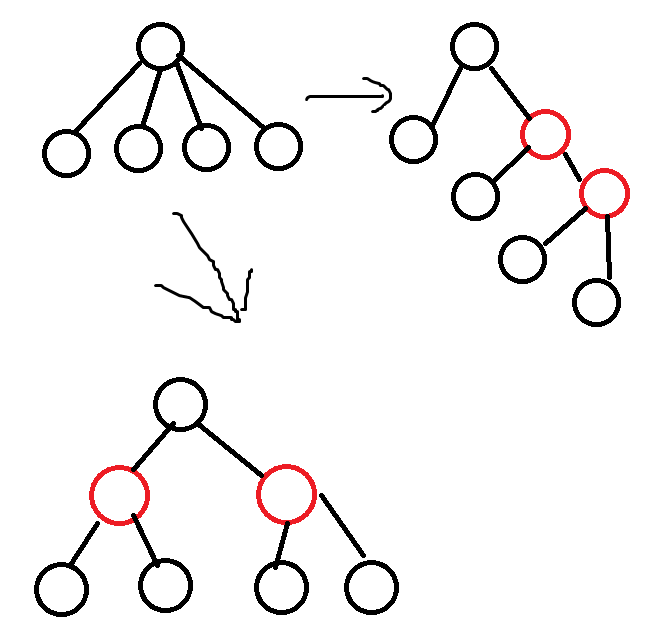1
2
3
4
5
6
7
8
9
10
11
12
13
14
15
16
17
18
19
20
21
22
23
24
25
26
27
28
29
30
31
32
33
34
35
36
37
38
39
40
41
42
43
44
45
46
47
48
49
50
51
52
53
54
55
56
57
58
59
60
61
62
63
64
65
66
67
68
69
70
71
72
73
74
75
76
77
78
79
80
81
82
83
84
85
86
87
88
89
90
91
92
93
94
95
96
97
98
99
100
101
102
103
104
105
106
107
108
| #include <bits/stdc++.h>
#define pb push_back
#define fi first
#define se second
using DB = double;
const int N = 1e5 + 100;
const DB eps = 1e-4;
int n, numl, numr;
bool del[N << 2];
DB res, lp[N << 1], rp[N << 1], l = 0, r = 1e6, mid, ans;
std::vector< std::pair<int, int> > G[N << 1];
int h[N << 1], idx = 0, mxs, si[N << 1], rte, cl, cr, hh, tt;
struct Edge{ int ne, ver, w; } e[N << 2];
std::pair<DB, int> q[N << 1];
void add(int x, int y, int z){ e[idx] = {h[x], y, z}, h[x] = idx++; }
void dfs(int x, int fa)
{
for (int i = h[x]; ~i; i = e[i].ne) if (e[i].ver != fa)
{
dfs(e[i].ver, x);
G[x].pb({e[i].ver, e[i].w});
}
}
void rebuild()
{
dfs(1, -1);
std::memset(h, -1, sizeof h), idx = 0;
for (int i = 1, lc, rc; i <= n; ++i)
if (G[i].size() <= 2)
for (auto t : G[i]) add(i, t.fi, t.se), add(t.fi, i, t.se);
else
{
lc = ++n, rc = ++n;
add(i, lc, 0), add(lc, i, 0);
add(i, rc, 0), add(rc, i, 0);
for (auto t : G[i]) G[lc].pb(t), std::swap(lc, rc);
}
}
void get_rt(int x, int fa, int tot)
{
si[x] = 1;
for (int i = h[x], y, mx; ~i; i = e[i].ne) if (!del[i] && (y = e[i].ver) != fa)
{
get_rt(y, x, tot);
si[x] += si[y], mx = std::max(si[y], tot - si[y]);
if (mx < mxs) mxs = mx, rte = i;
}
}
void walk(int x, int fa, int len, DB w, DB *p, int &cp, bool is)
{
if (is)
{
if (cp < len) p[cp = len] = w;
else p[len] = std::max(w, p[len]);
}
si[x] = 1;
for (int i = h[x], y; ~i; i = e[i].ne) if (!del[i] && (y = e[i].ver) != fa)
{
walk(y, x, len + (e[i].w != 0), w + e[i].w - mid * (e[i].w != 0), p, cp, is | (e[i].w != 0));
si[x] += si[y];
}
}
void calc(int x, int tot)
{
mxs = n, rte = -1;
get_rt(x, -1, tot);
if (rte ==-1 || del[rte]) return ;
x = rte;
del[x] = del[x ^ 1] = true;
int lc = e[x].ver, rc = e[x ^ 1].ver;
walk(lc, rc, 0, 0, lp, cl = 0, 1);
walk(rc, lc, e[x].w != 0, e[x].w - mid * (e[x].w != 0), rp, cr = 0, e[x].w != 0);
hh = 1, tt = 0;
for (int i = 0, j = cl; i <= cr; ++i)
{
while (j >= 0 && i + j >= numl)
{
while (hh <= tt && q[tt].fi < lp[j]) --tt;
q[++tt] = {lp[j], j};
--j;
}
while (hh <= tt && i + q[hh].se > numr) ++hh;
if (hh <= tt) res = std::max(res, rp[i] + q[hh].fi);
}
calc(lc, si[lc]), calc(rc, si[rc]);
}
bool chk()
{
for (int i = 0; i < idx; ++i) del[i] = false;
res = -1e9;
calc(1, n);
return res >= 0;
}
int main()
{
std::memset(h, -1, sizeof h), idx = 0;
scanf("%d %d %d", &n, &numl, &numr);
for (int i = 1, x, y, z; i < n; ++i) scanf("%d %d %d", &x, &y, &z), add(x, y, z), add(y, x, z);
rebuild();
while (r - l > eps)
{
mid = (l + r) / 2;
if (chk()) ans = l = mid;
else r = mid;
}
printf("%.3lf\n", ans);
return 0;
}
|
